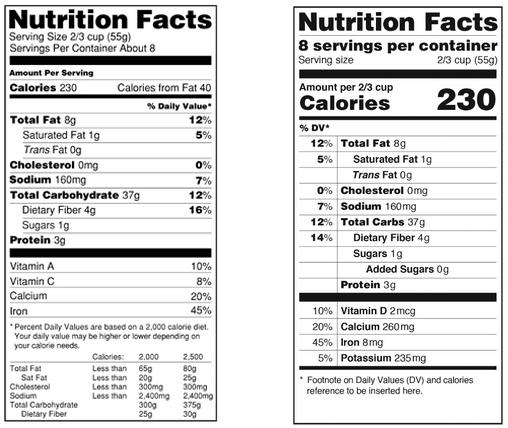FDA redesigns nutrition panel
Replies
-
I don't get this. I'm not American, so please forgive me if it is obvious! But I have to ask, because I've been trying to understand for a long time. Why isn't the focal point values pr 100 grams, wouldn't it make comparing different items easier? The serving size is what the user - or, the manufacturer - decides, or is it standardized in any way? And how do you use the %DV numbers, not that everybody is on a 2000 calories diet at all time...?
Because no one knows what 100g is.0 -
Pros: Tries to make it more obvious that the information is for A SERVING and not the whole damned container. Includes Vitamin D and potassium. Finally stops bothering people with the "Calories from fat" nonsense.
Cons: The percentages on the left make me twitchy. Protein is not at the top where it belongs.
It has always been obvious that it was for a serving and serving size was always listed, people just have to read it. And calories from fat are relevant to some people.0 -
The only complaint I have is... I would really like to see them put the caloric count for the whole package if there is more than one serving in it... granted I myself, may enter it into MFP and know... but it's not that hard to put back a box of mac and cheese all by one's self... even I can do that if I'm hungry enough.... or what about a can of pringles... it's not hard to knock one of those back either... and they have more than one serving in it.
cals per serving times serving per container.0 -
http://www.marketwatch.com/story/new-fda-nutrition-labels-may-change-your-food-2014-02-27?link=MW_home_latest_newsBut it could also have a darker side. Ronald Bazar, author of “Your Perfect Diet” thinks that “the food biz will do what it can to maintain sales, so no doubt the effect could be smaller sizes and the same price.” Indeed, the new labeling could cost the food industry an estimated $2 billion to carry out, so they have an extra incentive to maintain profit margins.
And they will do what they need to do to maintain profit margins.0 -
Not only that, but every grocery store I've been in has those "unit cost" labels but they never use the same units for anything. So the medium sized box of cereal is listed as "16.3¢ per ounce" and the large box of the same brand is listed as "$2.28 per pound."I don't get this. I'm not American, so please forgive me if it is obvious! But I have to ask, because I've been trying to understand for a long time. Why isn't the focal point values pr 100 grams, wouldn't it make comparing different items easier? The serving size is what the user - or, the manufacturer - decides, or is it standardized in any way? And how do you use the %DV numbers, not that everybody is on a 2000 calories diet at all time...?
The simple answer is... for no good reason! I WISH they just did things per 100 grams so it'd make everything easy, but we have a weird phobia of the metric system here. :ohwell:
I wish they did too. I especially hate when cereals are different serving sizes on different boxes.0 -
Great move to replace vitamin C and vitamin A with iron and potassium! Since when did we ever have to worry about those first two in the great old U S of A0
-
Yes! I am definitely happiest about the requirement for potassium. :drinker:
Same here!0 -
What I like
- Potassium amount is mandatory
- Vitamin D amount is mandatory
- Added Sugars denoted
- Fat Calories no longer called out that would give the impression that fat=bad.
- Font changes that highlight calorie count and %DV.
- The table at the bottom based on 2000 and 2500 calories per day goes away. This is nearly useless
what I don't like
- Implication that non-Added Sugars is "OK".
- Still rounding to nearest 5 calories, which is stupid for things like artificial sweeteners, which influence diet drinks
- I wish it incorporated kJ and kcal energy amounts.0 -
What I like
- Potassium amount is mandatory
- Vitamin D amount is mandatory
- Added Sugars denoted
- Fat Calories no longer called out that would give the impression that fat=bad.
- Font changes that highlight calorie count and %DV.
- The table at the bottom based on 2000 and 2500 calories per day goes away. This is nearly useless
what I don't like
- Implication that non-Added Sugars is "OK".
- Still rounding to nearest 5 calories, which is stupid for things like artificial sweeteners, which influence diet drinks
- I wish it incorporated kJ and kcal energy amounts.
I agree on all of your Pros, but I don't think the sugar/added sugar distinction gives any implication that a particular kind of sugar is "ok" any more than listing fat, carbs, sodium, etc. implies that they are "ok" or "not okay." There is enough difference of opinion on what is optimal/good/okay for these things, that it makes sense to make the distinction.
Personally, I'm fine with the 15 g of sugar in my cup of grapes, because of the benefits of grapes for my digestion, but I wouldn't be wise to choose with a drink or processed food that included the same proportion of added sugar. Not that I never eat sugary things (mmm...chocolate truffles), but I want to be more aware of added vs. not.
I also have trouble getting enough Vitamin A. I'm concerned that they are removing it from requirements, because if MFP removes it from the database/tracking, then I will have to do it by hand.0 -
Approved !0
-
Disagree. It will take me a while to get used to it. :ohwell:
ETA: not to mention increasing food costs even more...
Costs??
Right. They will have to redesign labels. You think the money fairy is paying for it?
The fda designed it. Food companies redesign packages constantly. This is more than negligible in terms of cost, and it gives more info.
Yes and another step in the direction of education.0 -
Does anyone know when everything will take effect ?0
-
I think the the alternate design that is also out there is even better (the one on the far right):
http://graphics8.nytimes.com/newsgraphics/2014/02/27/nutrition-label/bdeaa8c0dff25a8ff9881066ac063a65074cb971/nutrition-label-artboard_2.png
A much better arrangement for how the label is used.
- Energy details
- Items people watch to avoid too much of
- Items people watch to avoid too little of
Just wish there was a way to highlight protein. In my personal utopia protein:calorie ratio would be listed. By far the best measure of "clean" and "junk" (despite my hatred for the terms/concepts).0 -
In my personal utopia protein:calorie ratio would be listed. By far the best measure of "clean" and "junk" (despite my hatred for the terms/concepts).
That ratio - plus the $:protein ratio (lol) - is what I look for too.
And thank you everyone for your answers, I like to think that my concerns weren't totally off, haha. Not that it's funny, because confusion does make it harder to make an informed decicion and can add to the rise in obesity.
In Norway, we have the corresponding "green keyhole" http://www.nokkelhullsmerket.no/frontpage_en/?spraak=en to guide the costumers to the most healthy alternatives. I dislike it a lot, because "healthy" is such a complex term, and YMMV! In many cases, only the most expensive (brand) products gets the keyhole, most produce doesn't have it, and a few grams of fat may disqualify a product. Almost as confusing as your nutrition panel!0 -
Oooh, I do like the alternate design.I think the the alternate design that is also out there is even better (the one on the far right):
http://graphics8.nytimes.com/newsgraphics/2014/02/27/nutrition-label/bdeaa8c0dff25a8ff9881066ac063a65074cb971/nutrition-label-artboard_2.png
A much better arrangement for how the label is used.
- Energy details
- Items people watch to avoid too much of
- Items people watch to avoid too little of
Just wish there was a way to highlight protein. In my personal utopia protein:calorie ratio would be listed. By far the best measure of "clean" and "junk" (despite my hatred for the terms/concepts).0 -
No kidding. But, if you could do direct comparisons, you could easily see which one was cheaper, and then they wouldn't be taking more of your monies...
Not only that, but every grocery store I've been in has those "unit cost" labels but they never use the same units for anything. So the medium sized box of cereal is listed as "16.3¢ per ounce" and the large box of the same brand is listed as "$2.28 per pound."I don't get this. I'm not American, so please forgive me if it is obvious! But I have to ask, because I've been trying to understand for a long time. Why isn't the focal point values pr 100 grams, wouldn't it make comparing different items easier? The serving size is what the user - or, the manufacturer - decides, or is it standardized in any way? And how do you use the %DV numbers, not that everybody is on a 2000 calories diet at all time...?
The simple answer is... for no good reason! I WISH they just did things per 100 grams so it'd make everything easy, but we have a weird phobia of the metric system here. :ohwell:
I wish they did too. I especially hate when cereals are different serving sizes on different boxes.0 -
Although I approve of most of the changes, esp. the potassium addition, I don't think that this is going to help the obesity problem. Those who are obese and are not watching their intake are not going to read the label for the food that they are going to eat. This change will only help those who are interested in changing their eating habits.0
-
Here is my only real issue about the redesign:
Putting percentages first is out of context for everyone.
As a teacher of technical writing I am always telling my students that people need to know the main idea before we give them details. The "what" is the main idea here. What does this product contain that is good for me (or bad for me)?
We all like the information about total number of calories a serving and serving size at the top and easy to read because this is main idea: if we eat 1/4 a cup of trail mix it will be 160 calories. Why many of us don't like the left column with percentages is because it does not follow the rules.
Good technical writing theory would state that the most important information should come first, starting with what. So calories and serving size should obviously be first. What is next, if we do it by what people value, is going to be debated. However, if you go by FDA suggestions it should be carbohydrate, fat and protein information followed by nutrients our bodies need, and then at the end things we need to limit.
This suggestion would put salt and sugar at the very bottom of the panel making it easy to find. Generally speaking I will not put back an item for not containing enough of a vitamin or mineral but I will put it back for having too much salt, sugar or trans fat.
While, I can deal with whatever package design they throw at me and applaud the bigger font size (my husband often can't read box labels and it will be handy for him), it will be mildly depressing if I can use labels as an example in class of what not to do.0 -
Disagree. It will take me a while to get used to it. :ohwell:
ETA: not to mention increasing food costs even more...
Costs??
Right. They will have to redesign labels. You think the money fairy is paying for it?
The fda designed it. Food companies redesign packages constantly. This is more than negligible in terms of cost, and it gives more info.
Yes and another step in the direction of education.
Right, because $2 billion dollars is nothing. Food isn't expensive. These aren't the droids you're looking for.0 -
Disagree. It will take me a while to get used to it. :ohwell:
ETA: not to mention increasing food costs even more...
Costs??
Right. They will have to redesign labels. You think the money fairy is paying for it?
The fda designed it. Food companies redesign packages constantly. This is more than negligible in terms of cost, and it gives more info.
Yes and another step in the direction of education.
Right, because $2 billions dollars is nothing. Food isn't expensive. These aren't the droids you're looking for.
Wendy... these changes don't take effect for two years. There is plenty of time for corporations to make adjustments in the capital expenditure to accomodate this change. I'm not saying it won't cost anything, but it's not as devastating as you might think. From an operations standpoint, it will be a bit of pain, but like was previously mentioned, package redesigns aren't unheard of, and therefore, not something they can't deal with. It's not like they have to roll out new nutrition panels next week. Now THAT would cost a fortune!0 -
This is embarrassing, but since I'm beginning to need reading glasses and hate always having to dig them out of my purse, the larger font size is great.0
-
Disagree. It will take me a while to get used to it. :ohwell:
ETA: not to mention increasing food costs even more...
Costs??
Right. They will have to redesign labels. You think the money fairy is paying for it?
The fda designed it. Food companies redesign packages constantly. This is more than negligible in terms of cost, and it gives more info.
Yes and another step in the direction of education.
Right, because $2 billions dollars is nothing. Food isn't expensive. These aren't the droids you're looking for.
Wendy... these changes don't take effect for two years. There is plenty of time for corporations to make adjustments in the capital expenditure to accomodate this change. I'm not saying it won't cost anything, but it's not as devastating as you might think. From an operations standpoint, it will be a bit of pain, but like was previously mentioned, package redesigns aren't unheard of, and therefore, not something they can't deal with. It's not like they have to roll out new nutrition panels next week. Now THAT would cost a fortune!
Oh, I did mention that earlier. But let's not pretend that it's negligible. When the original labels were introduced, it increased food prices and put some small companies out of business. A friend of mine nearly went out of business. The two year time frame will help, but that only means the cost will be spread out over time. It doesn't mean that there will be no cost at all.
And saying "package redesigns aren't unheard of" is also a far cry from OP's claims that it happens "constantly." Also, the $2B figure is from the FDA, which is probably grossly underestimated, though we won't know for sure until we see the market effects,
You should check out the Market Watch link I posted earlier. It was a good list of the pros and cons for consumers, I think.0 -
Here is my only real issue about the redesign:
Putting percentages first is out of context for everyone.
As a teacher of technical writing I am always telling my students that people need to know the main idea before we give them details. The "what" is the main idea here. What does this product contain that is good for me (or bad for me)?
We all like the information about total number of calories a serving and serving size at the top and easy to read because this is main idea: if we eat 1/4 a cup of trail mix it will be 160 calories. Why many of us don't like the left column with percentages is because it does not follow the rules.
Good technical writing theory would state that the most important information should come first, starting with what. So calories and serving size should obviously be first. What is next, if we do it by what people value, is going to be debated. However, if you go by FDA suggestions it should be carbohydrate, fat and protein information followed by nutrients our bodies need, and then at the end things we need to limit.
This suggestion would put salt and sugar at the very bottom of the panel making it easy to find. Generally speaking I will not put back an item for not containing enough of a vitamin or mineral but I will put it back for having too much salt, sugar or trans fat.
While, I can deal with whatever package design they throw at me and applaud the bigger font size (my husband often can't read box labels and it will be handy for him), it will be mildly depressing if I can use labels as an example in class of what not to do.
I agree completely. Most people are completely clueless about what those percentages mean or have any way to put them in context. I always ignore them. But then, I tend to buy single-ingredient items anyway, so they don't even have these labels on them.0 -
Not sure why I'm even weighing in on this, but when the original label was required, it would require a redesign of the entire package because it has to incorporate a large box of information, and everything used to be in that space had to be put somewhere else. Swapping some information around in a box that is the same size will be much more cost effective. It will take some redesign, but should be much cheaper than the initial change.Disagree. It will take me a while to get used to it. :ohwell:
ETA: not to mention increasing food costs even more...
Costs??
Right. They will have to redesign labels. You think the money fairy is paying for it?
The fda designed it. Food companies redesign packages constantly. This is more than negligible in terms of cost, and it gives more info.
Yes and another step in the direction of education.
Right, because $2 billions dollars is nothing. Food isn't expensive. These aren't the droids you're looking for.
Wendy... these changes don't take effect for two years. There is plenty of time for corporations to make adjustments in the capital expenditure to accomodate this change. I'm not saying it won't cost anything, but it's not as devastating as you might think. From an operations standpoint, it will be a bit of pain, but like was previously mentioned, package redesigns aren't unheard of, and therefore, not something they can't deal with. It's not like they have to roll out new nutrition panels next week. Now THAT would cost a fortune!
Oh, I did mention that earlier. But let's not pretend that it's negligible. When the original labels were introduced, it increased food prices and put some small companies out of business. A friend of mine nearly went out of business. The two year time frame will help, but that only means the cost will be spread out over time. It doesn't mean that there will be no cost at all.
And saying "package redesigns aren't unheard of" is also a far cry from OP's claims that it happens "constantly." Also, the $2B figure is from the FDA, which is probably grossly underestimated, though we won't know for sure until we see the market effects,
You should check out the Market Watch link I posted earlier. It was a good list of the pros and cons for consumers, I think.0 -
From their press release:
The agency is accepting public comment on the proposed changes for 90 days.
http://www.fda.gov/NewsEvents/Newsroom/PressAnnouncements/ucm387418.htm0 -
Great changes. Much more readable and calorie content as well as servings per container are now featured much more prominently.
EDIT: Potassium content is now mandatory!! This is probably more significant than the panel redesign.
Just my 2 cents and all, but...
-there's no need to make the calories *that* large. They weren't difficult to find before. On the plus side, I'm glad they got rid of the calories from fat. Seemed useless.
-On the subject of seeming useless, just ditch the daily values for macros and cholesterol, etc. I'm fine with them for micros, despite a lack of context.
-Yay potassium!
-Ironically, the change to the servings per container actually makes it harder to locate because it just blends more easily into the Nutrition Facts label at the top.
-remove the serving per amount just above the annoyingly large Calories label. I was fine with Amounts Per Serving.
-This probably isn't huge, but I'd kind of like to see soluble and insoluble fiber broken out.0 -
I really like the new design, the only thing I wish they would do is have a "per 100g" or "per 100ml" column, like in other countries. That way it is harder for them to use the serving size and laws about rounding down to hide certain things. If the serving size is 28g, and it has 0.4g of Trans-fat, they can put 0g on the label. But, if they also had to show it for 100g then you could easily tell there was some in there (it would show 1g because they could still round down again).0
-
YESSSSSSS!!!! that made my day:flowerforyou:0
-
I really like the new changes and think the changes will be beneficial to almost everyone!0
-
I hate the games companies play with the serving size. It needs to be standardized.
Now, if we could just get restaurants on the same system.0
This discussion has been closed.
Categories
- All Categories
- 1.4M Health, Wellness and Goals
- 398.2K Introduce Yourself
- 44.7K Getting Started
- 261K Health and Weight Loss
- 176.4K Food and Nutrition
- 47.7K Recipes
- 233K Fitness and Exercise
- 462 Sleep, Mindfulness and Overall Wellness
- 6.5K Goal: Maintaining Weight
- 8.7K Goal: Gaining Weight and Body Building
- 153.5K Motivation and Support
- 8.4K Challenges
- 1.4K Debate Club
- 96.5K Chit-Chat
- 2.6K Fun and Games
- 4.8K MyFitnessPal Information
- 12 News and Announcements
- 21 MyFitnessPal Academy
- 1.5K Feature Suggestions and Ideas
- 3.2K MyFitnessPal Tech Support Questions





















